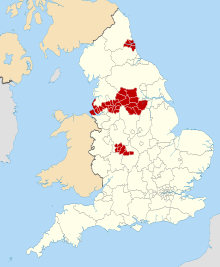Ametropolitan borough(ormetropolitan district) is a type oflocal government districtin England. Created in 1974 by theLocal Government Act 1972,metropolitan boroughs are defined inEnglish lawas metropolitan districts withinmetropolitan counties.All of the metropolitan districts have been granted or regrantedroyal chartersgiving themborough status(and in some cases, they also havecity status).[1]Metropolitan boroughs have been effectivelyunitary authorityareas since the abolition of metropolitan county councils by theLocal Government Act 1985.[2]Metropolitan boroughs pool much of their authority in joint boards and other arrangements that cover whole metropolitan counties, such asLocal enterprise partnershipsandCombined authorities and combined county authorities,with most of the latter having a directly electedmetropolitan mayor.
| Metropolitan district | |
|---|---|
| |
 | |
| Category | Local authority districts |
| Location | England |
| Found in | Metropolitan county |
| Created by | Local Government Act 1972 |
| Created |
|
| Number | 36 (as of 2008) |
| Possible status |
|
| Additional status |
|
| Populations | 0.1 - 1.1 million |
History
editLondon metropolitan boroughs (1900–1965)
editThe term "metropolitan borough" was first used for administrative subdivisions of theCounty of Londonbetween 1900 and 1965. There were 28 of these metropolitan boroughs, which were replaced by a new system of largerLondon boroughsin 1965, when the County of London was replaced byGreater London.
Current metropolitan boroughs
editThe current metropolitan boroughs originated as metropolitan districts created in 1974 as subdivisions of new metropolitan counties, created to cover the six largest urban areas in England outside Greater London. The new districts replaced the previous system ofcounty boroughs,municipal boroughs,andurbanandrural districts.
Metropolitan districts were originally parts of a two-tier structure of local government, and shared power with metropolitan county councils. They differed fromnon-metropolitan districtsin the division of powers between district and county councils. Metropolitan districts werelocal education authorities,and were also responsible forsocial servicesandlibraries.In non-metropolitan counties these services were (and are) the responsibility ofcounty councils.[3]
Many metropolitan districts were boroughs from their establishment on 1 April 1974; others gainedborough statuslater.
In 1986 the metropolitan county councils were abolished under the Local Government Act 1985 and most of their functions were devolved to the metropolitan boroughs, making them, to a large extent,unitary authoritiesin all but name. At the same time some of the functions of the abolished metropolitan county councils were taken over by joint bodies such aspassenger transport authorities,and jointfire,policeandwaste disposalauthorities.[2]
Metropolitan district councils
editThe metropolitan districts are administered by metropolitan district councils. They are the principallocal authoritiesin the six metropolitan counties and are responsible for running most local services, such as schools, social services, waste collection, and roads.[4]
The 36 metropolitan boroughs are:
| Metropolitan county | Metropolitan districts | Number | County population[citation needed] |
|---|---|---|---|
| Merseyside | Liverpool,Knowsley,St Helens,Sefton,Wirral | 5 | 1,365,000 |
| Greater Manchester | Manchester,Bolton,Bury,Oldham,Rochdale,Salford,Stockport,Tameside,Trafford,Wigan | 10 | 2,573,200 |
| South Yorkshire | Sheffield,Barnsley,Doncaster,Rotherham | 4 | 1,290,000 |
| Tyne and Wear | Newcastle upon Tyne,Gateshead,South Tyneside,North Tyneside,Sunderland | 5 | 1,299,000 |
| West Midlands | Birmingham,Coventry,Dudley,Sandwell,Solihull,Walsall,Wolverhampton | 7 | 2,916,458 |
| West Yorkshire | Leeds,Bradford,Calderdale,Kirklees,Wakefield | 5 | 2,161,200 |
See also
edit- Borough
- County borough
- ISO 3166-2:GB,subdivision codes for the United Kingdom
- Metropolitan boroughs of the County of London
- Non-metropolitan district
- Political make-up of local councils
- Subdivisions of England
References
edit- ^Local Government Act 1972, Schedule I, Part I, Metropolitan Counties and Metropolitan Districts
- ^abLocal Government Act 1985 c.51
- ^Local Government in England and Wales: A Guide to the New System.London:HMSO.1974. p. 7.ISBN0-11-750847-0.
- ^"Understand how your council works".Retrieved28 December2023.